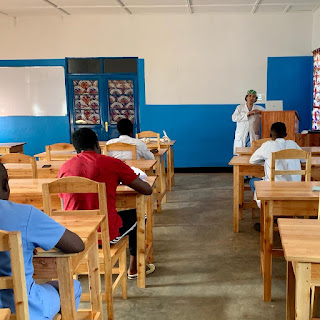(by Ted John)
A few months ago, I wrote a post on medical education and my
experience organizing a 2-week dental course for the medical students, which
you can read more about here. It was the first time teaching such a course at
our hospital and the first time for me to coordinate/organize a course. Since
we don’t have any dentists on site, teaching was done exclusively through audio/video
recordings and live video conferencing.
Fast forward a few months, and I have now finished coordinating
a new course on orthopedics and trauma. Here’s a table to give you an idea of
how they were similar and different, at a glance.
|
|
Dental |
Ortho/Trauma |
|
Number of students
enrolled |
46 |
52 |
|
Duration of
course |
2 weeks |
5 weeks |
|
Number of
instructors |
3 |
6 |
|
Number of (different)
lectures |
9 |
29 |
|
% of lectures
taught in English (PPT slides in French) |
78% |
26% |
|
Method of
instruction |
tele-education |
in-person (some
distance learning) |
Of course, there are a number of other differences. For
example, the scope of the ortho/trauma course was broader, but more related to
general surgery (at least as it pertains to trauma). Thus, while it would be ideal for
orthopedic surgeons to teach the more strictly ortho topics, we did the best
with what we had in terms of available expertise. In what other context could
you imagine an ortho/trauma course taught by a motley of 4 general surgeons, an
ER doctor, and a visiting orthopedic surgeon? 😄
 |
| Lecturing in our newly renovated classroom |
Another big difference was that not all students were
present for the in-person instruction at Kibuye. At any given point in time
during the course, there were 8-16 students doing clinical rotations off-site
in Bujumbura. As a result, it required more effort and coordination to ensure
that these students could have timely access to recorded lectures and
corresponding slides. The usual routine was that as soon as an instructor finished
giving their lecture, they would send me their recorded audio file, which I would
then upload to Dropbox (along with their slides). Then there’s the logistics of
administering quizzes and exams in two locations simultaneously, getting scanned
copies of the completed off-site quizzes, and grading and reporting all students’ results
in a timely manner. Doing this in the US with high-speed internet and ubiquitous
Wi-Fi would be challenging in and of itself, so accomplishing this in our
context is nothing short of incredible.
 |
| Medical students taking one of their weekly quizzes |
Here’s a condensed list of the content we covered:
• ATLS/Burns
• Trauma of the spine and chest
• Trauma/fractures of the upper extremities (shoulder, humerus, elbow, forearm/wrist, hand)
• Trauma/fractures of the lower extremities (hips, femur, knee, ankle)
• Musculoskeletal infections and tumors
• Differences in the pediatric population (plus congenital abnormalities)
 |
| Skeleton models of bones and joints were available for students throughout the course |
We’re also thankful for Joel Post, an orthopedic surgeon who visited for 2 weeks during the middle of the course. We intentionally planned the course to correspond with when he was around so that we and the students could benefit from his expertise. With Dr. Post’s fellowship training in orthopedic oncology as well as traumatology, he was the perfect person to give the lectures on osseous tumors and ankle fractures (which I view as generally more complex both in terms of injury patterns and management). As I sat in the back of the room listening to him, with stories of patients from his own current clinical practice, I couldn’t help but think, “Wow, this is so interesting. I wish Joel could teach all the ortho lectures!”
 |
| My family with Joel just before his return to the US |
Overall, though, I’m quite pleased with how the course
turned out, and I think the students learned a lot. As with the dental course,
I recognized the top performing students, but this time with little bags of calcium
supplements (tums) for fun. I even trialed an electronic post-course survey through
google forms to solicit feedback, the template for which others can continue
using in future courses going forward. In response to the question of what was
the best part of the course, a good number of students said “everything”. Yet, I
know there’s room for improvement, and will take to heart the students’
suggestions for the next time this course is taught again in a couple years. For
now, I can redirect my attention elsewhere, perhaps in helping with the start
of a surgery residency training program in the coming months. Tibia continued...
 |
| Group photo with the Kibuye cohort of students at the end of the course |

No comments:
Post a Comment